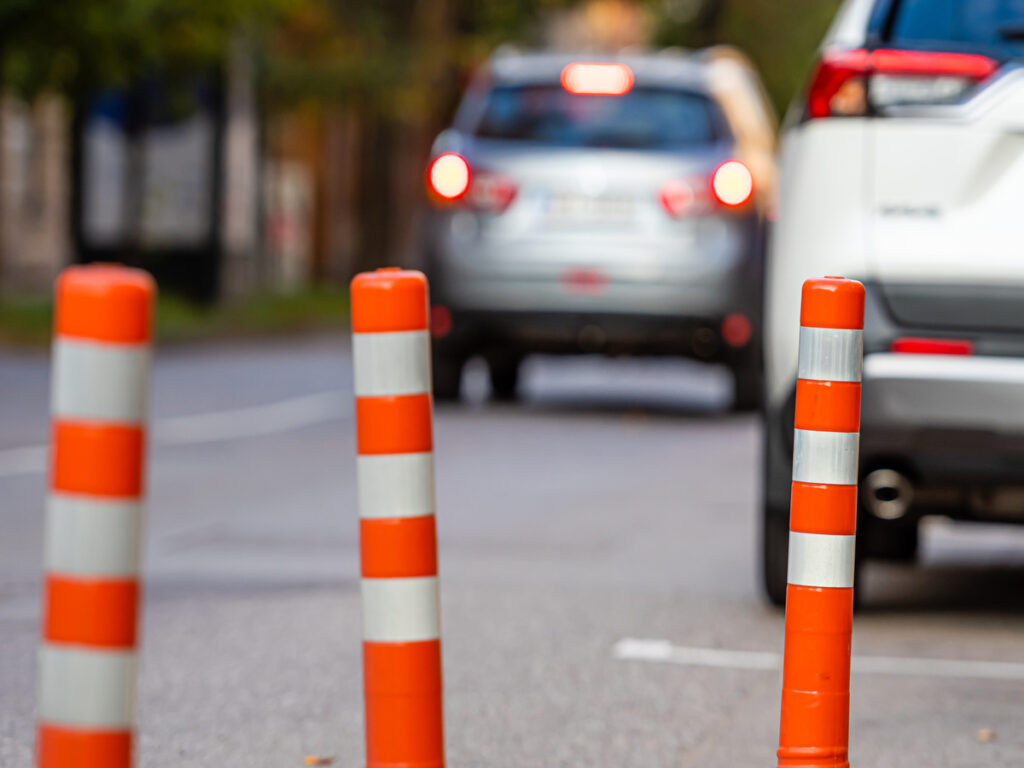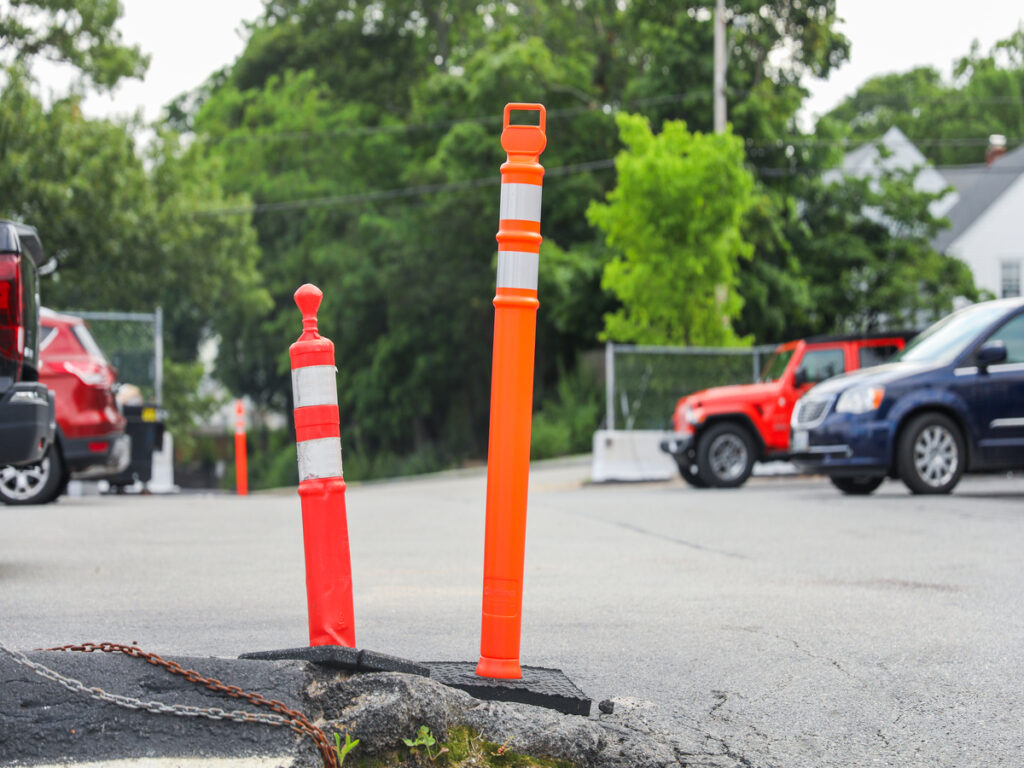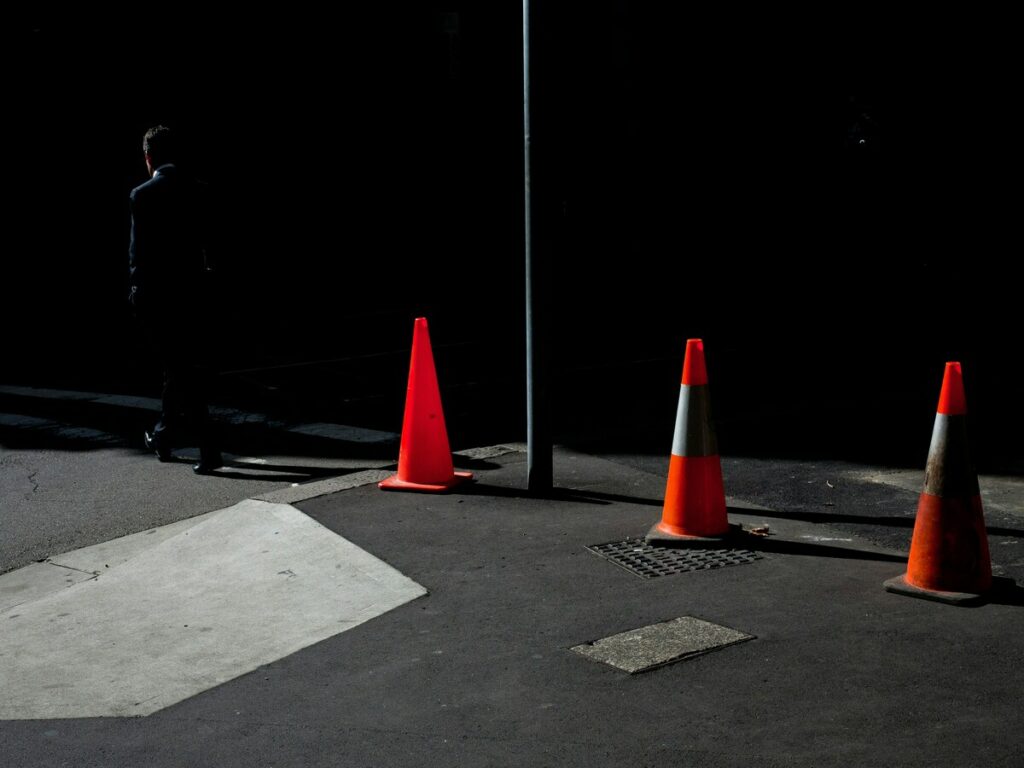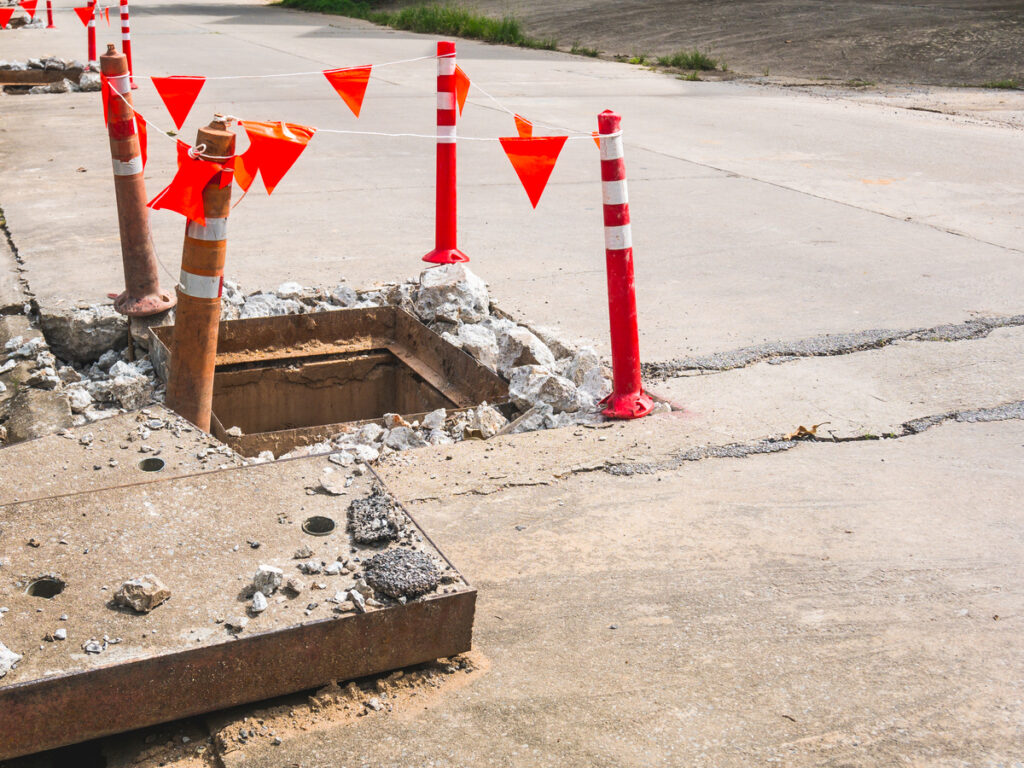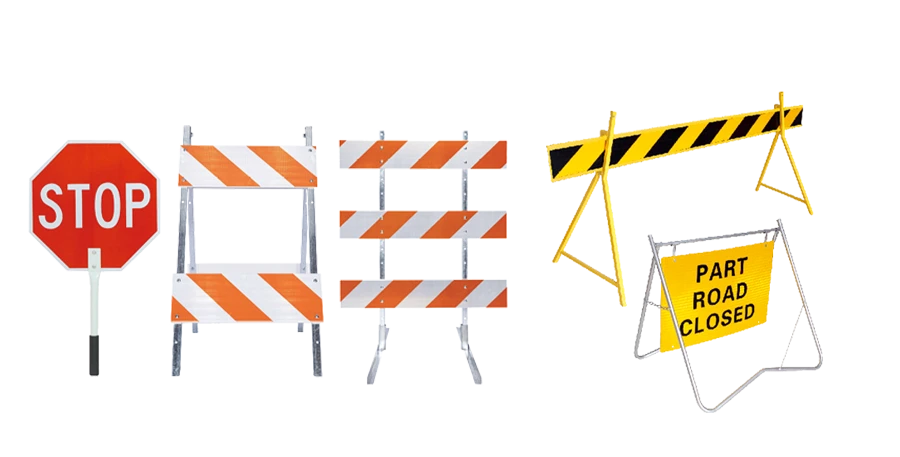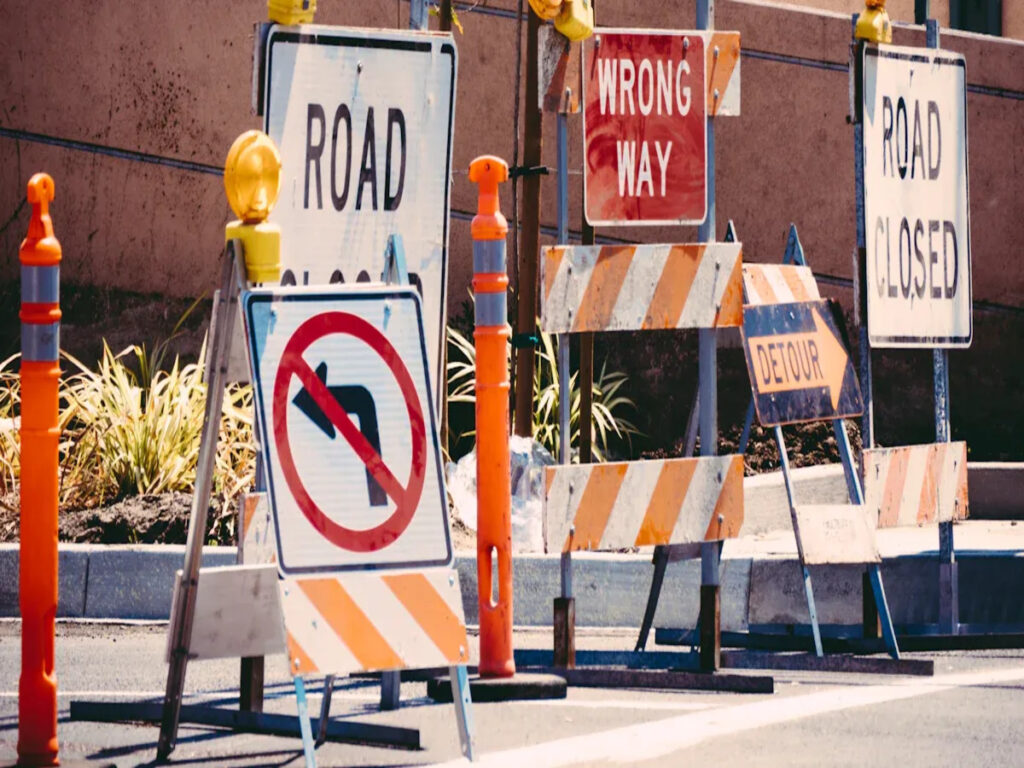
A crew puts custom construction signs at a busy jobsite. In the morning, they see one sign has fallen in soft mud. Unstable ground is a big safety risk. Workers need to prepare well to keep signs standing and easy to see. Using the right way to install signs for the ground helps stop accidents and follows the rules.
En OPTRAFICO, we understand that proper sign installation is critical for safety on construction sites. That’s why we provide custom construction signs designed for easy visibility and durability, Incluso en entornos desafiantes. Whether you’re dealing with soft ground, vientos fuertes, o uneven terrain, nuestro high-quality signposts y stabilizing bases ensure that your signs stay upright and visible. Our expert solutions help your crew adhere to safety standards while minimizing the risk of accidents. OPTRAFICO offers the right tools to keep your jobsite safe and compliant, making it easier to install signs securely and efficiently.
Control de llave
- Check the ground before you put up signs. Knowing the soil type stops signs from falling down.
- Pick the best way to install signs for the ground. Use heavy bases for soft soil. Use anchors for sandy or loose ground.
- Look at the signs often to make sure they stay up. Checking a lot helps you find problems early and keeps people safe.
- Choose strong materials for signs. Aluminum and PVC do not break easily from weather or soil. This makes signs last longer.
- Follow OSHA rules for sign safety and visibility. Doing this keeps workers safe and lowers the chance of accidents.
Understanding Unstable Ground
Why Standard Sign Installs Fail
Construction crews have trouble putting up signs on unstable ground. Usual ways, like pushing posts into dirt or using light bases, do not make signs steady enough. Wind can blow the sign over or make it lean. Big machines moving close by shake the ground. This makes signs move or fall. Loose soil cannot keep the sign standing straight. Bumpy ground has dips and bumps that weaken the sign’s support. If the ground sinks, it means the soil is not strong. Cracks in pavement or foundations show bigger problems below. All these things make it hard for signs to stay safe and easy to see.
Consejo: Always look at the ground before you put up a sign. Signs need strong ground to stand up and work well.
Types of Unstable Terrain
Unstable ground comes in many types. Each type changes how well signs stay up. Crews must know the ground to pick the best way to install signs.
- Mud and soft earth: Signs sink and lose support.
- Arena: Moving sand does not hold signs well.
- Grava: Loose rocks make the base wobbly.
- Fresh fill dirt: Dirt packs down later, so signs may lean.
- Cracked pavement: Shows the ground moves under it.
- Uneven surfaces: Dips and bumps mean weak soil.
- Sinking structures: Show the ground is not strong.
- Semi-stable ground: Packed soil helps but can still move.
- Paved surfaces: Need gentle ways for short-term installs.
Some fixes help make the ground better. Soil nailing adds extra support to the ground. Geotextiles stop soil from washing away and help it stay strong. Lime stabilization makes soil harder and less wet. Crews should use the right method for each ground type to get the best results.
Assessing Your Jobsite Surface
Classifying Ground Conditions
Crews need to know what kind of ground they have. This helps stop accidents and keeps signs standing. Workers look at the soil and check it with simple tests. They use tools to see how hard or soft the ground is. El Unified Soil Classification System and AASHTO System help sort the ground types. These systems use things like grain size and color. Workers use a sand grain size chart and a soil color book. These show if the ground is sandy, muddy, or rocky. Geotechnical gauges tell how much weight the ground can hold. The Modified Burmister System is another way to rate ground strength.
- Soil Sampling & Visual Classification
- Unified Soil Classification System (USCS)
- AASHTO Soil Classification System
- Modified Burmister System
- Soil Pocket Penetrometer
- Pocket Shear Vane Tester
- Sand Grain Size Chart
- Geotechnical Gauge
- Munsell Soil Color Book
Crews use these tools and systems to see if the ground is soft, perder, or semi-stable. This helps them choose the best way to put up each sign.
Identifying Site Hazards
Teams look for dangers that make the ground weak. Risk checks find problems like loose soil and water. Many experts check the ground during the project. They watch for changes as work goes on. IoT devices help watch underground and warn crews about moving ground.
One time, a trench fell in during a pipeline job. The ground was not checked well, and the right support was not used. This shows why it is important to check ground strength before and during work.
- Do a full risk check to find dangers like loose soil and water.
- Use many experts to check risks during the project.
- Keep watching underground with IoT devices to find problems early.
Crews who check the ground and look for dangers keep signs safe and workers protected.
Installation Solutions for Custom Construction Signs
Picking the right way to install signs helps keep them safe and easy to see. This is important, even if the ground is not steady. Each method works best for certain places and needs. The next parts tell you when to use each way and what to think about for safety.
Weighted-Base Systems
Weighted-base systems are good for custom construction signs on soft or finished ground. Crews use heavy things like sandbags or rubber plates to hold signs steady. These bases do not hurt pavement or finished ground. This way works well on paved spots, packed dirt, and places where digging is not allowed.
| Estrategia | Descripción |
|---|---|
| Ponderación | Crews put sandbags or rubber bases to stop signs from falling in strong wind. |
| Wind Blockers | Teams set signs near trees or buildings to block wind. |
| Wind-Friendly Designs | Signs with holes let air go through, so they do not tip over. |
| Controles regulares | Workers look at signs often to make sure bases are safe and not broken. |
Weighted-base systems help signs stand up to wind by making them less like sails. Crews should figure out how heavy the base needs to be for each sign. They must think about wind and sign size. Big custom construction signs need extra bracing for more strength. Many bases have locks or anchor points to stop people from taking signs.
Consejo: Weighted-base systems make it easy to move custom construction signs when the site changes.
Ground-Anchoring Methods
Ground-anchoring methods give strong support for custom construction signs on loose or sandy soil. Crews push stakes, rebar, or earth anchors deep into the ground to reach solid layers. This way is best for long jobs where signs must stand up to wind and moving soil.
| Ground Anchoring Method | Suitable Soil Conditions | Descripción |
|---|---|---|
| Passive Anchor | Clay soils, gentle slopes | Uses the earth’s grip to keep signs steady. |
| Tension Anchor | Steep slopes, high walls | Holds signs with strong steel cables. |
| Rock Bolt | Steep rock slopes | Drilled and glued to hold signs on rocks. |
Crews pick the anchoring way based on soil and how long the job lasts. Passive anchors are good for clay. Tension anchors work on steep slopes. Rock bolts help on rocky ground. Strong anchoring keeps custom construction signs up during storms and when big machines move nearby. Many systems have bolts that are hard to remove or hidden anchor heads to stop theft. Wind-friendly sign panels help air move through and keep signs steady.
Nota: How deep anchors go is important. Crews must push anchors past the weak top layer to reach strong ground.
Concrete Footings and Driven Posts
Concrete footings and driven posts are the most lasting way to put up custom construction signs on firm or hard ground. Crews dig small holes, set posts, and fill them with packed dirt or concrete for strong support. This way stands up to wind, sacudida, and lots of traffic.
- Digging holes can take less than an hour or longer, depending on the ground.
- Getting equipment ready and putting it away takes extra time.
- Labor costs are about $290, and materials cost around $73.50, so the total is about $363.50 Para cada signo.
- Other jobs, like getting permits and talking to customers, add at least 30 minutos.
- Labor costs can go up if the weather is bad.
- Concrete footings cost $0.50 a $8 for each foot, with an average of $150 for each footing.
- Getting the area ready before work helps save money.
- Booking work in slow seasons lowers labor costs.
- Good footings stop expensive repairs, which can start at $1,500.
- Getting prices from different workers helps control costs.
Concrete footings hold custom construction signs deep in the ground to fight wind. Driven posts are good for smaller signs or when concrete is not needed. Crews should pick strong posts and panels with wind-friendly features, like holes or tough edges. Strong anchoring keeps signs from falling or being stolen.
Para la punta: Concrete footings and driven posts give the best support for custom construction signs in tough places.
Choosing the Right Custom Construction Sign
Sign Material and Durability
Eligiendo el best material for a construction sign es importante. It helps the sign last longer and stay strong in tough places. Teams pick materials that do not get ruined by water or chemicals. They also want signs that can handle bad weather. Aluminum is strong and does not break easily. Funciona bien afuera. PVC is good for both inside and outside. It does not get damaged by water or chemicals. Coroplast is good in bad weather. It does not fade or rust. Some signs use 3M™ materials with sticky glue. These signs work inside and outside. Weather-resistant signs have special layers. These layers stop fading and rust. Outdoor safety signs are made to be seen and last in hard places.
| Material | Características |
|---|---|
| CLORURO DE POLIVINILO | Water and chemical resistant, suitable for indoor and outdoor |
| Aluminio | Durable, withstands harsh conditions |
| Coroplast | Resistente a la intemperie, resists fading and corrosion |
| 3M™ materials | Permanent adhesives, withstands harsh conditions |
| Resistente a la intemperie | Recubrimientos protectores, resists fading and damage |
| Outdoor safety sign | Designed for durability and visibility in tough environments |
The material you pick changes how long the sign stays clear. Materiales reflectantes help people see signs at night or in dark places. Metal and strong vinyl do not break down from weather or lots of use. These things help keep yard signs easy to see and safe, even on shaky ground.
Consejo: Always pick a sign material that matches the weather and ground at your site.
Post Design and Compatibility
The way a sign post is made helps it stay up and makes it easy to put in. Teams use different posts for different ground and ways to install. Level topped fence posts are good for bumpy ground. Crews can change the height after putting them in. Stepped fence posts are best for steep hills. They make steps but can leave holes at the bottom. Racking fence posts bend with the slope. They are good for small hills.
| Post Design | Descripción |
|---|---|
| Level Topped Fence | Ideal for uneven ground, allows height adjustments after installation |
| Stepped Fence | Best for steep slopes, creates steps in the fence line, may leave gaps at the base |
| Racking Fence | Follows the slope, suitable for slightly sloping areas without leveling |
Cable anchor systems use strong steel cables to help hold up signs on slopes. These systems work with shotcrete and wire mesh for more support. Teams often use more than one way to keep yard signs standing in hard places.
When buying custom yard signs, teams should think about the post style and how it works with the way they will put it in. The right mix keeps signs steady and easy to see, even if the ground is not stable.
5-Step Secure Installation Checklist
Survey and Classify Terrain
Crews start by looking at the jobsite. They check for dangers and things in the way. They also look at local rules. Workers use their eyes and simple soil tests to see what kind of ground is there. They clean up trash and make sure the area is neat. This helps teams pick the best way to put in yard signs. It also helps make the soil stronger if needed.
Select Installation System
After checking the ground, teams pick the best way to install signs. They use a table to compare what matters most:
| Criterios | Importancia |
|---|---|
| Limpieza de la superficie | Helps glue and coatings stick better |
| Surface Profile Depth | Makes the sign hold to the ground better |
| Inspection Methods | Checks with eyes and rules for accuracy |
| Jobsite Cleanliness Standard | Gives everyone a clear goal for cleaning |
Teams match the way they install signs to the ground type. They use weighted bases for paved ground. They use ground anchors for loose dirt. Concrete footings are used for signs that need to last a long time.
Gather Tools and Materials
Workers get all tools and parts before starting. They use special tools like drive shanks and driver heads. Hand post drives help put signs in safely. Regular tools may not be strong enough. Teams check that every sign part is there and not broken. They clean the ground again if needed.
Install and Test Stability
Crews put in yard signs using the chosen way. They measure and mark spots to be exact. Después de poner el letrero, they test if it stands strong. Teams look for cracks or uneven ground. Some jobs need soil tests like triaxial compression or direct shear tests. These checks stop problems and keep signs standing. Teams may look at old data to see if the ground moved before. Testing makes sure the sign will stay up.
Consejo: Always check if each sign is stable after you put it in. This helps stop problems later.
Schedule Regular Inspections
Teams plan regular checks to keep signs safe and easy to see. They look for dirt, desvanecimiento, o daño. Checking often helps follow rules and stops accidents. Workers clean signs and fix problems fast. Regular checks show how important strong installation is and keep yard signs working well.
Regular care and checks help every sign stay strong at the jobsite.
Putting up custom construction signs the right way keeps workers safe. It also helps sites follow OSHA rules. Teams pick the best way for each ground type. This makes signs easier to see and stops accidents. Checking signs often and using simple designs helps on shaky ground. Experts say to use strong materials. They also say to change signs when the site changes.
| Mejor práctica | Descripción |
|---|---|
| Cumplimiento de Regulaciones OSHA | Uses the right colors and sizes so signs work well. |
| Customization for site needs | Changes signs to help people see and understand them better. |
Construction workers should choose the best signs for each site. They should ask experts for help when the ground is hard to work with.
Preguntas frecuentes
How does unstable soil affect sign installation?
Unstable soil can cause signs to tilt, sink, or fall. Workers must check soil type before installing any sign. Loose or wet soil needs extra support. Teams often use anchors or weighted bases to keep signs upright on shifting soil.
What is the best method for installing signs on sandy soil?
Crews prefer ground-anchoring systems for sandy soil. They drive stakes or earth anchors deep into the soil to reach stable layers. Sandy soil shifts easily, so anchors must go past the loose top soil for reliable support.
Can signs stay secure on gravel soil?
Gravel soil makes sign bases wobbly. Teams use weighted bases or ground anchors to stabilize signs. Gravel soil does not hold posts well, so workers check soil compaction and may add extra soil or support under the base.
How often should crews inspect signs installed on soft soil?
Crews inspect signs on soft soil daily. Soft soil changes quickly, especially after rain. Workers look for leaning signs or soil erosion. Regular checks help prevent accidents and keep signs visible. Teams also test soil firmness during inspections.
What materials work best for signs on unstable soil?
Aluminum and PVC work well on unstable soil. These materials resist moisture and chemicals found in soil. Teams choose posts that match soil conditions. Los materiales resistentes ayudan a que los carteles duren más, even when soil shifts or gets wet.
Consejo: Always match sign material and post design to the soil type for best results.

